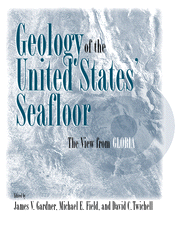Book contents
- Frontmatter
- Contents
- Contributors
- Foreword
- Introduction
- Part I The GLORIA System and Data Processing
- Part II U. S. East Coast EEZ
- Part III Gulf of Mexico and Caribbean EEZ
- Introduction
- 5 Breaching the Levee of a Channel on the Mississippi Fan
- 6 Morphology of Carbonate Escarpments as an Indicator of Erosional Processes
- 7 Sedimentary Processes in the Salt Deformation Province of the Texas-Louisiana Continental Slope
- 8 Sedimentary Processes in a Tectonically Active Region: Puerto Rico North Insular Slope
- 9 A Review of the Tectonic Problems of the Strike-Slip Northern Boundary of the Caribbean Plate and Examination by GLORIA
- Part IV U. S. West Coast EEZ
- Part V Alaskan EEZ
- Index
6 - Morphology of Carbonate Escarpments as an Indicator of Erosional Processes
Published online by Cambridge University Press: 25 January 2010
- Frontmatter
- Contents
- Contributors
- Foreword
- Introduction
- Part I The GLORIA System and Data Processing
- Part II U. S. East Coast EEZ
- Part III Gulf of Mexico and Caribbean EEZ
- Introduction
- 5 Breaching the Levee of a Channel on the Mississippi Fan
- 6 Morphology of Carbonate Escarpments as an Indicator of Erosional Processes
- 7 Sedimentary Processes in the Salt Deformation Province of the Texas-Louisiana Continental Slope
- 8 Sedimentary Processes in a Tectonically Active Region: Puerto Rico North Insular Slope
- 9 A Review of the Tectonic Problems of the Strike-Slip Northern Boundary of the Caribbean Plate and Examination by GLORIA
- Part IV U. S. West Coast EEZ
- Part V Alaskan EEZ
- Index
Summary
Abstract
Large sections of the Blake, Florida, and Campeche Escarpments have been imaged by GLORIA, and this common data type allows a comparison of the morphology of these escarpments and inferences about the erosional processes that have shaped them. Four morphologic provinces have been identified as follows: (1) shallow valleys with tributary gullies, which coincide with areas of minimal erosion of the platform edge; (2) box canyons, which overlie areas of differential basement subsidence and fractured carbonate rocks; (3) straight terraced sections coinciding with areas of more uniform basement subsidence, but where varying lithologies exposed at the platform edge are being differentially eroded; and (4) straight unterraced sections where the lithologies of the carbonate rocks appear to be uniform. These different provinces are interpreted to be surficial expressions of processes that have shaped these escarpments through their histories.
Introduction
The escarpments at the edges of the Blake-Bahama, Florida, and Yucatan carbonate platforms are some of the largest cliffs on the surface of the earth. The Blake Escarpment extends along the eastern side of Florida and the northern Bahamas for about 450 km and has as much as 4,000 m relief. The Florida Escarpment extends along the western side of Florida for about 650 km and has about 2,000 m relief. The Campeche Escarpment rings the eastern and northern margins of the Yucatan Peninsula and has about 2,000 m relief (Figure 6–1).
- Type
- Chapter
- Information
- Geology of the United States' SeafloorThe View from GLORIA, pp. 97 - 108Publisher: Cambridge University PressPrint publication year: 1996

